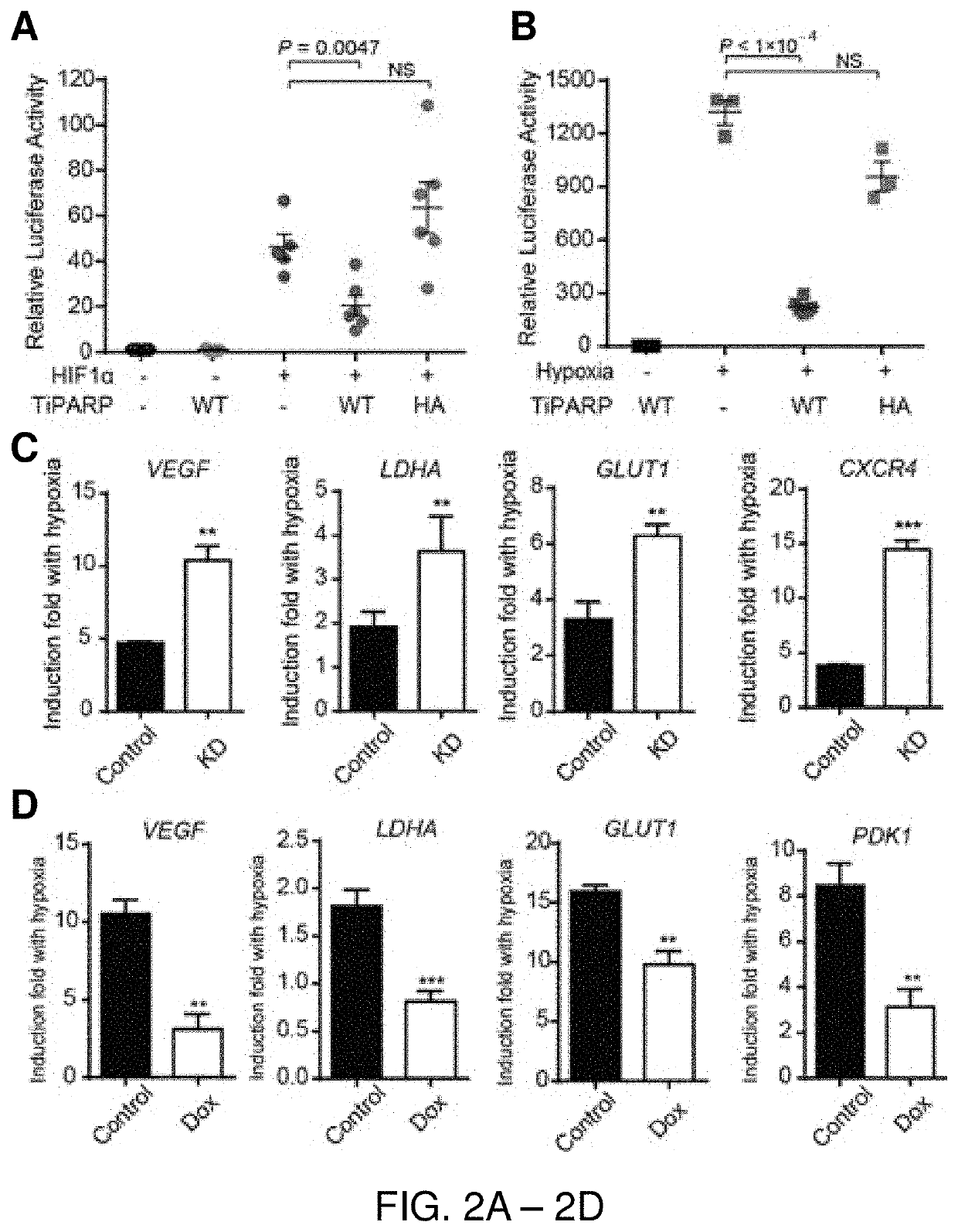Methods of upregulating tiparp as anticancer strategies
a technology of anticancer strategies and tiparp, which is applied in the field of upregulating tiparp as anticancer strategies, can solve the problems that the detailed function of tiparp and its role in modulating transcription is not well understood, and achieves the effects of regulating cmyc protein levels, and reducing cmyc protein levels
- Summary
- Abstract
- Description
- Claims
- Application Information
AI Technical Summary
Benefits of technology
Problems solved by technology
Method used
Image
Examples
example 1
and Methods
Cell Culture, Hypoxic Incubation and Transfection
[0093]MCF-7, RCC4 and HEK293T cells were obtained from the American Type Culture Collection (Manassas. Va.), and were cultured in Dulbecco's modified Eagle's medium (Gibco, 11965-092) supplemented with 10% heat-inactivated fetal bovine serum (FBS, Gibco, 26140079). HCT116 cells were cultured in McCoy's 5A medium (Ser. No. 16 / 600,082) with 10% FBS. Cells were grown in a humidified atmosphere at 37° C. at gas tensions of 20% O2 / 5% CO2 for normoxic incubation and 1% O2 / 5% CO2 for hypoxic incubation. HIF-1α in cell lysates was detected by western blot with HIF-1α antibody (BD Biosciences).
[0094]For transient overexpression of proteins of interest, cells were transfected with expression vectors using FuGene 6 (Promega, E2691) according to the manufacturer's protocol. To stably knock down TiPARP, lentivirus was produced by transfecting HEK 293T cells with pCMV-ΔR8.2 (packaging vector), pM2D.G (envelope vector) and shRNAs (Sigma)....
example 2
a Direct Target Gene of HIFs
[0108]TiPARP was previously characterized as a TCDD-responsive gene regulated by AHR (Ma, Q. Arch Biochem Biophys 404, 309-316 (2002); Ma, Q. et al, Biochem Biophys Res Commun 289, 499-506, (2001)). In searching for other regulatory mechanisms for TiPARP, the inventors identified a potential hypoxia response element upstream of TiPARP exon 1 (FIG. 1A), implying that HIFs control TiPARP expression. To test this, the inventors examined mRNA level of TiPARP under hypoxia, which is a well-established model for studying HIFs function. Indeed, TiPARP mRNA was significantly up-regulated under hypoxia (2) in both HCT116 and MCF-7 cell lines (FIG. 1B). Additionally, TiPARP mRNA level was increased by the treatment of hypoxia-mimetic agents dimethyloxalylglycine (DMOG) and desferrioxamine (DFO), or over-expression of HIF-1α (FIG. 1C) or HIF-2α (FIG. 7A).
[0109]To further confirm TiPARP is a target gene of HIFs, luciferase reporter assay was performed in HEK 293T cel...
example 3
presses HIF-1 Transcriptional Activity
[0110]TiPARP has been documented to modulate the activity of transcription factors by ADP-ribosylation (MacPherson, L. et al. Nucleic Acids Res 41, 1604-1621, (2013); Bindesboll, C. et al, Biochem J 413, 899-910, (2016)). Thus, the inventors asked whether it also regulates HIFs transcriptional activity. Using a HRE-luciferase reporter construct, the inventors assessed whether TiPARP affects the transcriptional activity of HIF-1α. As a positive control, the reporter gene was significantly induced by HIF-1α over-expression (FIG. 2A) or hypoxia (FIG. 2B). Co-transfection of TiPARP with HIF-1α resulted in a significant decrease of reporter gene expression (FIG. 2A), indicating that HIF-1α transactivation was inhibited by TiPARP. hi addition, TiPARP dramatically repressed the transcriptional activity of endogenous HIF-1α under hypoxia (FIG. 2B). Moreover, the catalytic activity of TiPARP was required for the inhibition, as expressing catalytically in...
PUM
| Property | Measurement | Unit |
|---|---|---|
| molecular weight | aaaaa | aaaaa |
| molecular weight | aaaaa | aaaaa |
| molecular weight | aaaaa | aaaaa |
Abstract
Description
Claims
Application Information
 Login to View More
Login to View More - R&D
- Intellectual Property
- Life Sciences
- Materials
- Tech Scout
- Unparalleled Data Quality
- Higher Quality Content
- 60% Fewer Hallucinations
Browse by: Latest US Patents, China's latest patents, Technical Efficacy Thesaurus, Application Domain, Technology Topic, Popular Technical Reports.
© 2025 PatSnap. All rights reserved.Legal|Privacy policy|Modern Slavery Act Transparency Statement|Sitemap|About US| Contact US: help@patsnap.com



